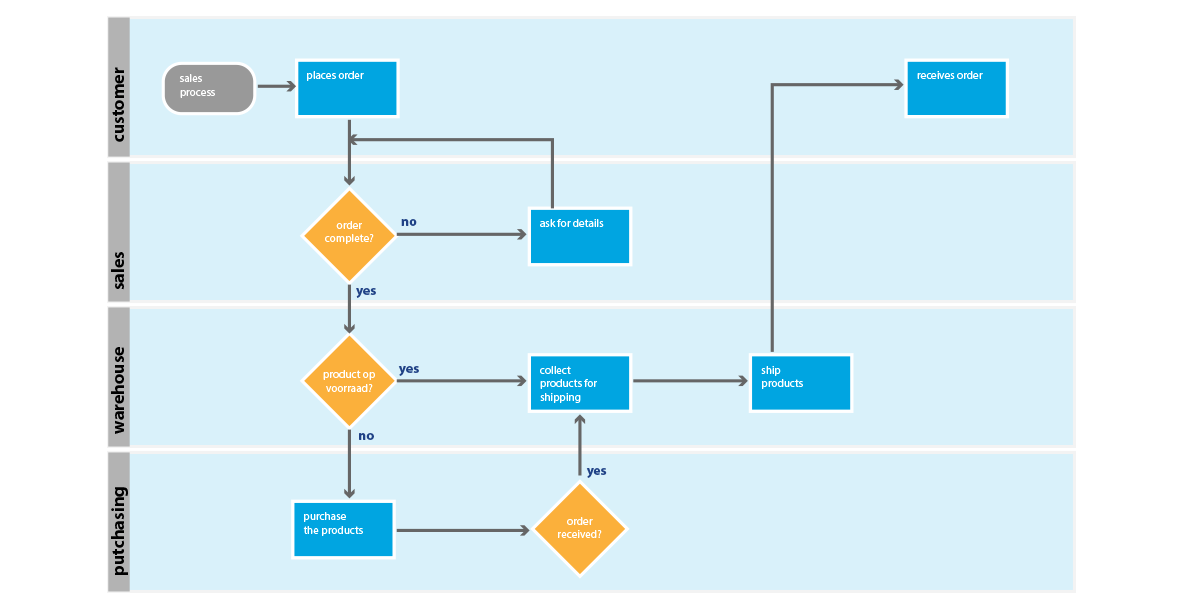Swimlanes: challenges of successful process management
Companies have always been looking for ways to improve their process management, and various tools and techniques have been developed over the years to help with that.
One such tool is the swimlane diagram, which is used in many organizations to map and visualize business processes.
However, there are a few challenges that can arise when using swimlanes. In practice, we see that these challenges occur mainly in the following 2 situations:
- If the swimlanes are visualized "statically," for example using Visio, Miro, Canva, Lucidchart or another visualization tool.
- If swimlanes are deployed as a stand-alone process management tool.
So in this article, we'll take you through these challenges - and much more importantly, how to build a successful process management system within your organization.
What are Swimlanes: the meaning
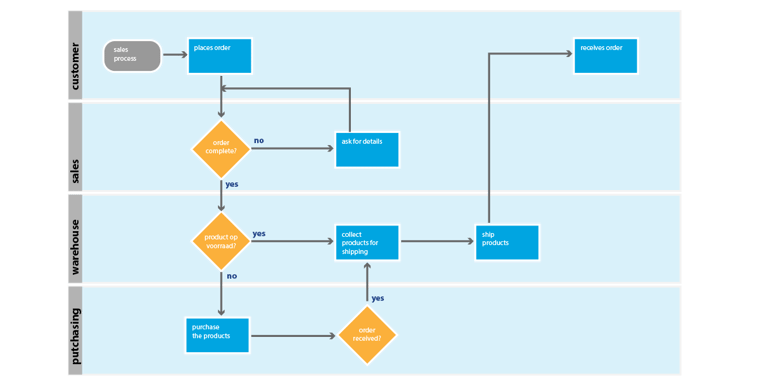
Swimlanes are a system of parallel lines that visually divides process steps into categories. The difference from normal flow charts is that the swimlane diagram shows who must perform which step. Each "swim lane" or flow shows which activities must be performed by a specific department or team.
The purpose of swimlanes is to make it easier to see which tasks are performed by which departments or individuals, and to identify potential bottlenecks.
The use of swimlanes is popular as process visualization. Often the diagram is developed in a visualization tool such as Visio, and then shared with stakeholders in the process.
In our experience, using swimlanes in this way falls short, and creates (unnecessary) challenges.
Challenge 1: They are drawings
Don't get us wrong - we actually encourage visualizing processes. However, the limitation of the swimlane diagram is that in many organizations it remains just that - a loose drawing, a picture. A stand-alone diagram that is not part of a bigger picture.
Challenge 2: They are not vivid processes
Because the swimlane diagram is often visualized as a static image, it does not show the dynamics of a process. To be truly effective, process management must be a continuous and iterative activity. Swimlane diagrams do not lend themselves as well to this.
Challenge 3: No connectivity
Swimlane diagrams do not show the interrelationships between processes and, for example, the systems used. For example, a customer order can trigger a production process, which in turn will trigger a logistics process.
The visualization of this is missing in a static swimlane diagram. A swimlane diagram shows only one process at a time and does not show how this particular process relates to its environment, where the process result must be continued, for example.
Challenge 4: Inconsistency
There is no standard method for drawing swimlane diagrams. Consequently, we have seen in several organizations that colleagues, teams, or departments create or complete swimlanes in different ways. This lack of consistency can lead to differences in interpretation, confusion, and misunderstandings.
Challenge 5: No outputs defined
In swimlane diagrams, it's all about the activities performed in a process.
In our experience, it is actually essential to define the output so that it is clear what the end result of a process should be. Because the result is not clear in swimlanes, processes lack a clear purpose. A goal you can measure, reflect and steer on.
For this reason, it is very important not to use swimlanes as a stand-alone tool; after all, the swimlane diagram lacks important information.
Challenge 6: Missing details
Because swimlanes are often depicted on 1 A4 sheet, there is a tendency to leave out details. This may be acceptable for very high-level overviews, but it quickly becomes a problem when you want to use swimlanes as a basis for process management.
In the latter case, you need to go into much more detail to avoid unnecessary errors. For example, we recommend defining the 6 control aspects for each output in your process. Which IT systems do we deploy to create this output? Who is responsible? What risks are involved?
Challenge 7: Background information missing
Thus, if you extend this line, underlying information is also missing. When you draw out swimlane diagrams on paper and use them on their own, they are two-dimensional, and cannot show the background information that is so important for performing the tasks described in the diagram.
Precisely by working with a relational database in which information flows centrally, you ensure that each colleague has access to the knowledge he or she needs to do their job.
So what does work?
So how do you ensure that you build a system in which information flows centrally? That you map out processes in a way that ensures everyone has access to the information they need to do their jobs?
By working with process management software like Comm'ant, you create one central, digital space in which all information about the processes is collected. This way you always have an up-to-date picture of what is happening in the organization and you can be sure that everyone involved is working with the same information.
The Comm'ant system is built on a combination of 2 models for process descriptions, ensuring that no detail is missed and the overview is clear for everyone: the Waterfall model and the SIPOC model.
In the Comm'ant system, you visualize the process in a way that (similar to the swimlane diagram) makes it clear at a glance who (colleague / team / department) is responsible for which tasks within the process, but also immediately makes the interrelationship and information flows clear.
The Waterfall Model

With the waterfall model, processes are represented as logical sequential steps, or "phases." This makes it easy to see how information flows through the organization and the associated processes relate to each other.
Het SIPOC model

The SIPOC model (supplier, input, process, output, customer) then helps you to map, per process, the activities (or process steps) with the associated information flows in detail. With this model, unlike swimlanes, not only the activity to be performed is visible.
The model also shows who is the "supplier" of the required information (the one who provides input) and who is the "customer" of a process (the one to whom the output, the process result, is delivered).
So in this view, in addition to the activity (the execution), attention is also given to the result of a process. Why?
Because this allows everyone who is part of the process to know exactly what their output must meet. This increases the chance that your product or service will meet the set requirements and quality many times over.
Mapping processes with Comm'ant
When you use Comm'ant to map your processes, the system ensures that everyone involved always has the most up-to-date information. This is because in Comm'ant all information about a process is collected in one place:
Bundling process chains 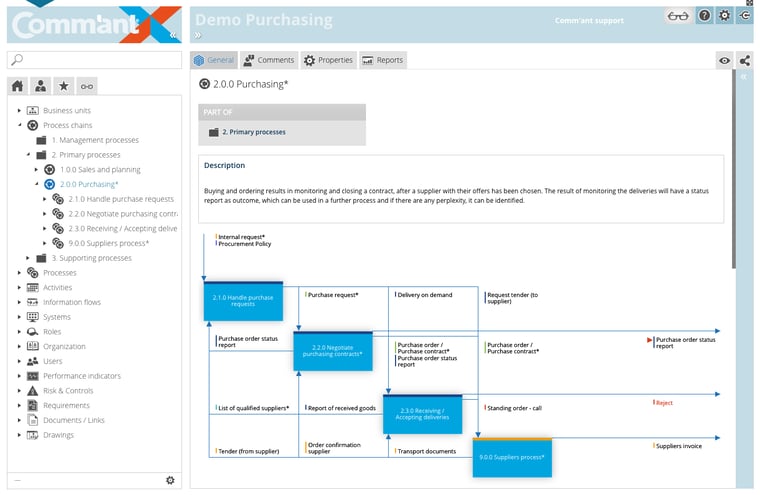
In the Comm'ant system, you bundle processes based on information flows. This makes it easy to see how the processes are related, and what their purpose is. This gives you a clear overview of all the processes in your organization.
Information centrally available
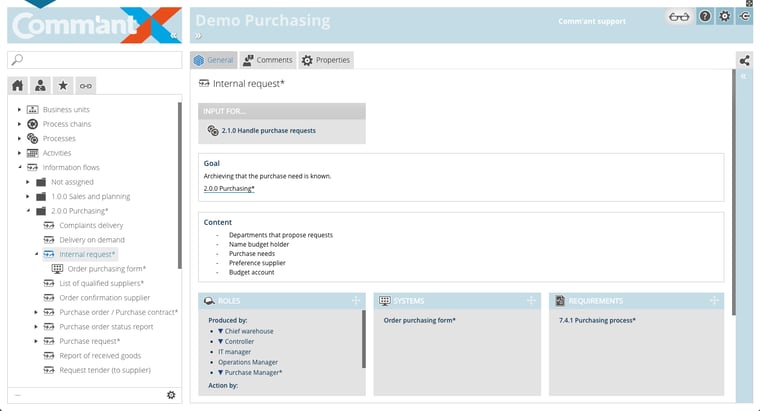
Comm'ant ensures that information about the process is always available to all stakeholders. This is because all relevant information about a (main) process is bundled in one place: from the detailed procedures, to roles and responsibilities, quality requirements and associated systems and documents.
Dynamics and connectivity in processes
Comm'ant allows you to map processes dynamically. This means you can easily change the order of steps or add new ones. You can also link processes together so that information only needs to be entered once. This saves a lot of time and ensures that everyone is always working with the same, up-to-date information.
Better collaboration with the help of Comm'ant
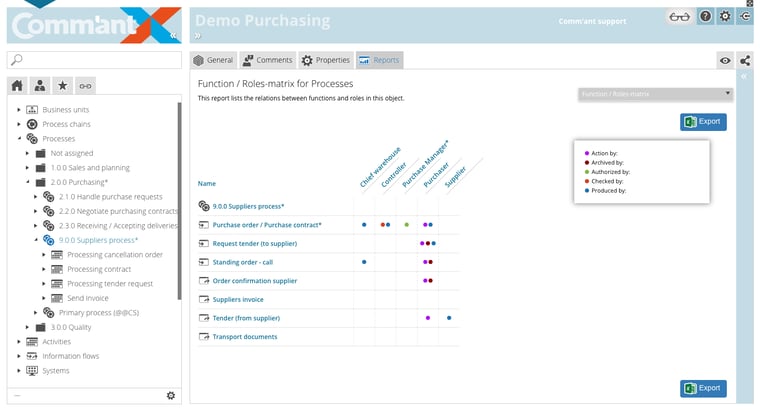
With Comm'ant, you create transparency and clarity about what needs to be done, when and by whom. That makes it easier for all involved to do their jobs well. In short: with our process management software, you work smarter, not harder!
Want to learn more about how Comm'ant can help your organization work better together? Then contact us for a free demo. Then together we'll see how we can help you establish a successful management system.


